Meet our dogs
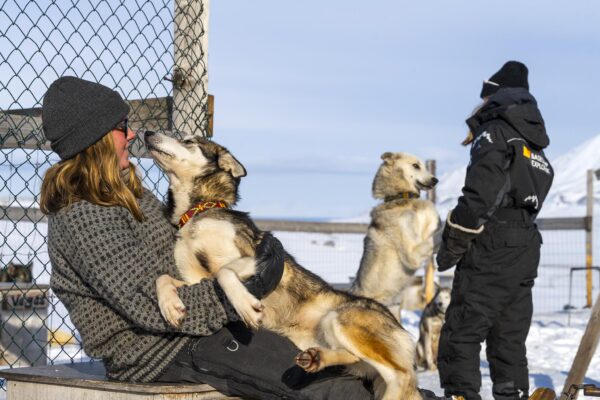
Facts about our dog yard
Location: Bolterdalen, 10 kilometers east of Longyearbyen
Dog breed: Alaskan husky
Number of dogs: Approx. 80, 50-50 male and female
Use: Sleigh rides and companionship
Why Alaska husky?
We have chosen Alaska huskies because they are very friendly and trusting dogs with a good disposition. They are social individuals, who love to live in groups. The Alaskan husky is a hard-working sled dog with great endurance. They are also easy to train and are very loyal.
What characterizes the Alaskan husky?
The Alaskan husky is not a purebred dog. It was bred from a cross between different dog breeds with qualities that have been desirable for this type of working dog. The origin stems from polar primordial dogs in Alaska and northern Canada, but has today through breeding lines obtained qualities from, among others, bird hunting dogs and the Siberian husky.
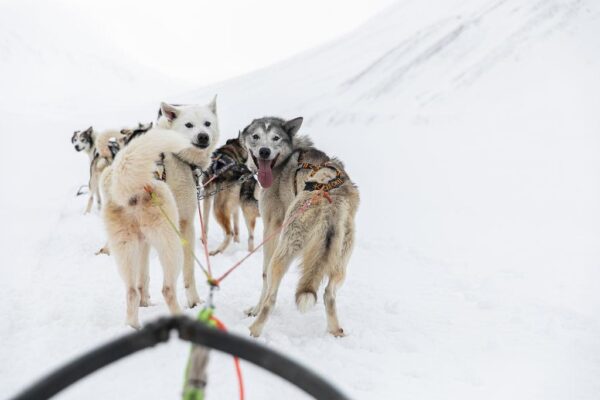
Alaskan huskies are very persistent, fast and hard-working sled dogs. They have a friendly disposition, are loving and are experienced as a loyal travel companion. They are social individuals, and it is important for an Alaskan Husky to surround himself with either other dogs or his human family. They are intelligent beings and love to learn.
Alaska huskies are very different in appearance, based on the fact that they are not purebred dogs. They come in various designs and shades of color including white, brown and black. Most have a narrow build, but some are more solid and broad. The dogs have either blue or brown eyes, and many actually have one blue and one brown eye. Females weigh 20-25 kilos, while a powerful male can weigh up to 35 kilos.
Alaskan huskies have a coat that consists of an inner layer of undercoat and an outer layer of top hair. The underwool keeps the dogs warm, while the outermost layer can be compared to a shell covering that closes against wind and precipitation. Dogs do not cool themselves with sweat through their skin as humans do, but rather through their breath and paws. This is how they seal the heat in, and with the help of the two layers of fur, the Alaskan husky stays warm down to -30 degrees Celsius, making it a robust dog in arctic regions. The dogs thrive in the cold, which you can see by the fact that they often lie curled up on the ground, and often under a good layer of snow.

The dog’s life course
A female is pregnant for approximately two months. Well before birth, we take the female into a closed room with its own yard. The room is covered with wood wool to keep mother and puppies warm and the floor soft. We always try to be present at birth, so that we can assist in the event of complications.
When the puppies are born, they automatically seek the mother’s teats to take in mother’s milk with important nutrients for the puppies so that they grow into healthy and fit dogs. The puppies grow quickly, and after two weeks they open their eyes. We spend a lot of time with the puppies after they have grown more robust. All the puppies try to copy their mother and they fight for attention. Then it is quickly done that a shy puppy can disappear in the crowd, and we have to actively help the little one with socialization.
When the puppies are four to six months old, they can begin a cautious approach to life as a sled dog. First, they must learn to walk with a harness, before they can be trained to pull. Then comes the big test of strength: Which position will suite the dog will be in the team?
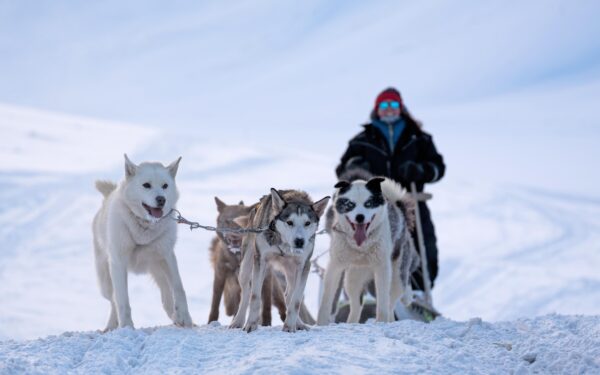
Guide dog, swing dog, sled dog or four-wheel drive?
The lead dogs are the ones put first in the team, who are responsible for keeping the line taut and pulling the team forward at a good pace. It is mostly females that are leader dogs. The boys have so much testosterone and adrenaline in their bodies that they lose concentration. We can often see early signs of whether a females will be a good leader dog. The swing dogs respond to the commands right and left, and steer the team in the right direction. The task of the sled dogs is to work steadily, while the four-wheel tractors are often the strongest, which are placed closest to the sled.
Alaskan Huskies love to struggle out in the field. They simply feel better from exerting a lot of energy in cold environments. As the temperatures rise, an Alaskan husky finds it hard. The fur is so thick that the dogs become more relaxed the more plus degrees they work in.
All our dogs are trained regularly, and we have forms that indicate the date, kilometers and level of effort for each training and long-distance walk that the individual dog undertakes. We quickly notice if a dog has not had enough mental and physical exercise, then it becomes restless and grumpy, something we do not want our dogs to be.
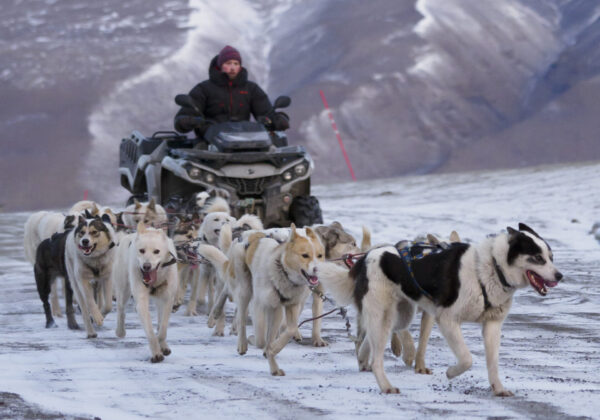
Niklas Wikstrand trains dogs before the winter season. Photo: Håkon Daae Brensholm
The dogs that are selected for longer expeditions must be specially trained for this. Then the length of the training trips is increased long in advance. They can run up to 40-70 kilometers a day on our trips. To put it in perspective, a well-trained racing dog that participates in the major competitions can run up to 200 kilometers a day.
After many years as a sled dog, the dogs’ physique deteriorates, just like with us humans. Then they move into retirement, and that usually means they move from the dog kennel in Bolterdalen. Someone gets to become a station dog at Isfjord Radio, others move to a selected family who guarantees that they will take good care of our four-legged friends.
PS: A few Alaskan Huskies do not enjoy being in packs or working as sled dogs. Then we find a good alternative for the dogs, and they move from Bolterdalen at a young age.
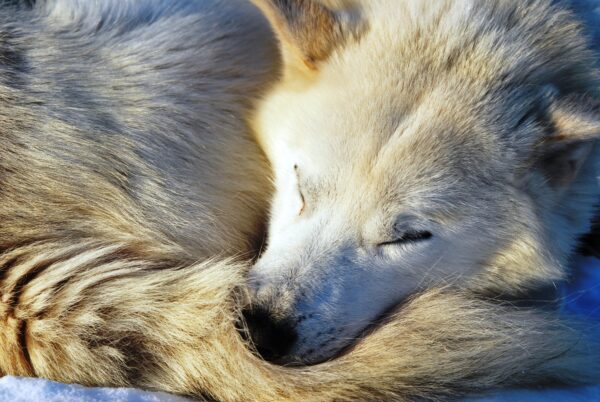
This is how the dogs live in the dog yard
The dog yard is divided into two main areas, where male dogs are gathered in one area and females in another. This is to reduce stress in the male dogs when the females are in heat. In addition, it gives us control over which dogs we want to mate and breed on.
There are separate, fenced areas for puppies and their mothers, as well as for dogs that need distance from the other dogs in the event of, for example, illness or injuries. In the fenced areas, the dogs have the opportunity to move more freely, explore and play with other dogs.
Each dog has its own house, which is placed on four legs slightly above the ground. The dogs are tied to the dog house, but have a radius of approximately two meters in which to move. Each house is placed at a distance which means that the dogs do not enter each other’s home area, and which gives the dogs the opportunity to retreat for some alone time if necessary.
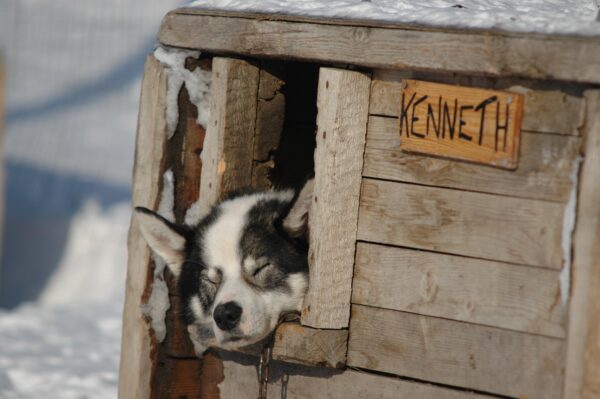
In the doghouses, the dogs have wooden wool that shelters them from the cold. Some dogs empty their homes for wood wool because they prefer to sleep without it or because they prefer to sleep outside with wood wool. It is especially male dogs that clean the house of wood wool. Reindeer antlers are attached to the dog houses, which the dogs chew on for play and dental health (reduces tartar). Some dogs chew several horns a month, while others barely touch theirs.
Food and feeding
An average Alaskan husky needs 5000-8000 kcal per day during normal activity. For longer trips, the calorie requirement is increased to 10,000+. The amount and type of feed is regulated according to the dog’s age and state of health. The dogs get a mixture of dry and soft food. The dry food and soft food are mixed together to form a soup that gives the dog plenty of nutrition and liquid.
In the summer, the dogs get a light meal in the morning and a larger meal in the evening. In winter, the amount of both meals is increased, and in addition there may be a need for a morning meal and snacks if the dogs are out on longer expeditions.
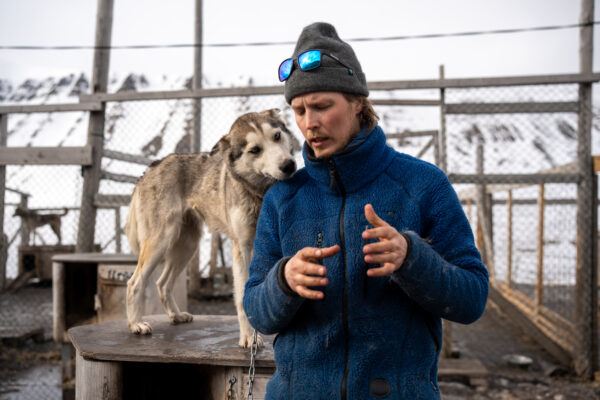
Trust and security! Two important parameters that Niklas always raises in his work with the dogs.
Healthy animal husbandry
Security creates calm, which creates trust!
All the dogs in our dog yard must have the best possible, both mentally and physically. We will talk about the dogs’ rights and look after them. It goes without saying that the dogs should have their surroundings clean, and at least twice a day we remove faeces and clean wood wool.
We feed according to each individual dog’s size, age and activity level, and the dogs have regular access to fresh water (sometimes the water dish becomes a toy that is thrown around).
The dogs are regularly trained, and activated through sled rides with guests or by the dog guides. In addition, some dogs are lucky and get to join us on walks.

We check our dogs daily for any injuries or illness. We also ask guests to look for abnormal behavior when we are on expeditions. Is there someone who limps or seems sloppy? Speak up!
Sledding dogs in the Arctic can quickly get injured. They can slip on the ice, step over and sometimes even the best friends end up in a fight. Preferably triggered by a female in heat. In case of more serious injuries or illness, the dogs are treated by a veterinarian in Longyearbyen.
Most important of all: Lots of love, time, consideration and security!!!
Our dogs love visits to the kennel, and they compete for attention and cuddles. Some jump and dance on the leash in the hope that you will approach them, while others are more modest and prefer that you approach carefully.

Harnesses and sleds
Each dog gets a harness that is adapted to the dog’s size and physique. That’s why we have many different harnesses. The harnesses must fit well and provide an even load on the body when the dogs are pulling. Large male dogs that pull closest to the sled often have a harness with an inserted “stick” behind the dog. It lowers the pulling point for the dog, and makes it more comfortable to pull.
The dogs are connected to the line set at two points. The front is attached to the dog’s collar, while the back is attached to the harness. This is the pulling point, while the foremost point keeps the dog together in the pack.
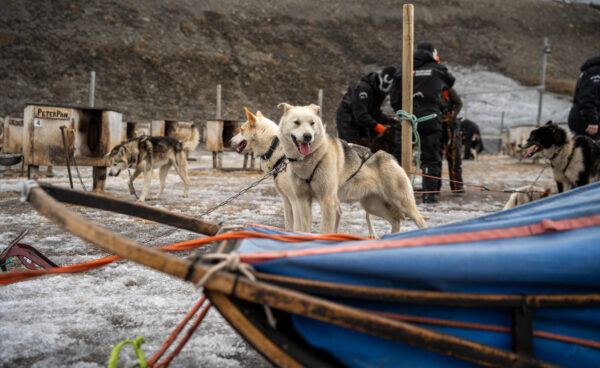
The dogs are attached to the sled at two points.
The sled consists of sled runners, brake, storage space and platform for the dog handler. In the storage room passengers or luggage can be loaded (in some cases a sled dog rests in the storage room if it is injured or tired).
The dog handler uses the brake to regulate the speed of the dogs. Especially on downhill slopes, things can go fast, and you have to brake so that the dog has time to move his legs. On uphill slopes or lots of snow, the dog handler often has to help the dogs with the sled.
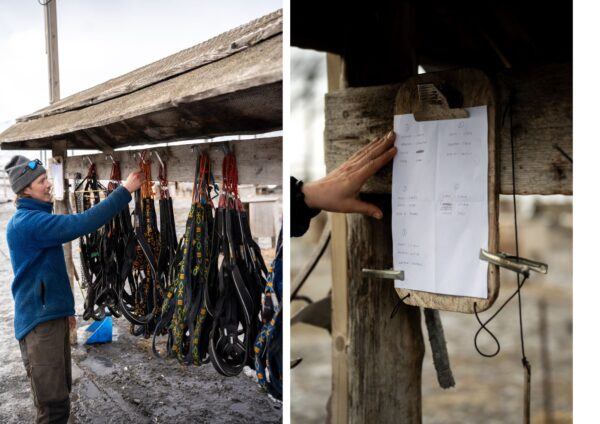
Niklas chooses a harness according to the dog’s size, and before the trip the teams are set up after careful assessment of the dogs’ position.
Fun fact: Dogs are like us, defecation is often triggered by activity. Therefore, you may find that there is a lot of pooing at the start of a trip.
How do dogs react to polar bears and other animals?
The dogs will react differently if they come into contact with polar bears. Some will alert, while others will get scared and will try to run away. If the dogs are on a leash, they can gain extra speed when they smell, for example, reindeer, grouse or other dogs.
Niklas Wikstrand
This article was written in collaboration with Niklas Wikstrand. He is a dog guide in Basecamp Explorer, and takes guests on, among other things, longer overnight trips with dogs and sleds.
Niklas started dog sledding in 2009, and has run long competitive races in Alaska. He himself has five Alaskan huskies, and has training in the physiological treatment of dogs. Healthy and safe dog keeping is absolutely essential for Niklas, and he uses his theoretical expertise in combination with extensive experience to look after our 80 Alaska huskies.

Niklas Wikstrand has extensive knowledge of dog keeping and dog sledding.
Niklas has taken various courses in dog anatomy and acupuncture. He treats muscular overloads with massage, and closely monitors whether strain injuries have occurred due to other ailments in the dog.
